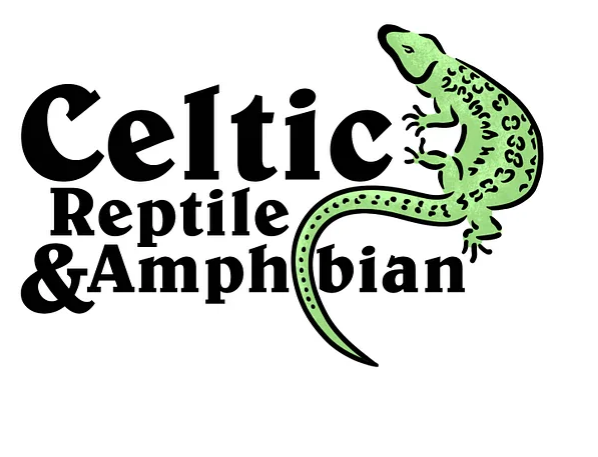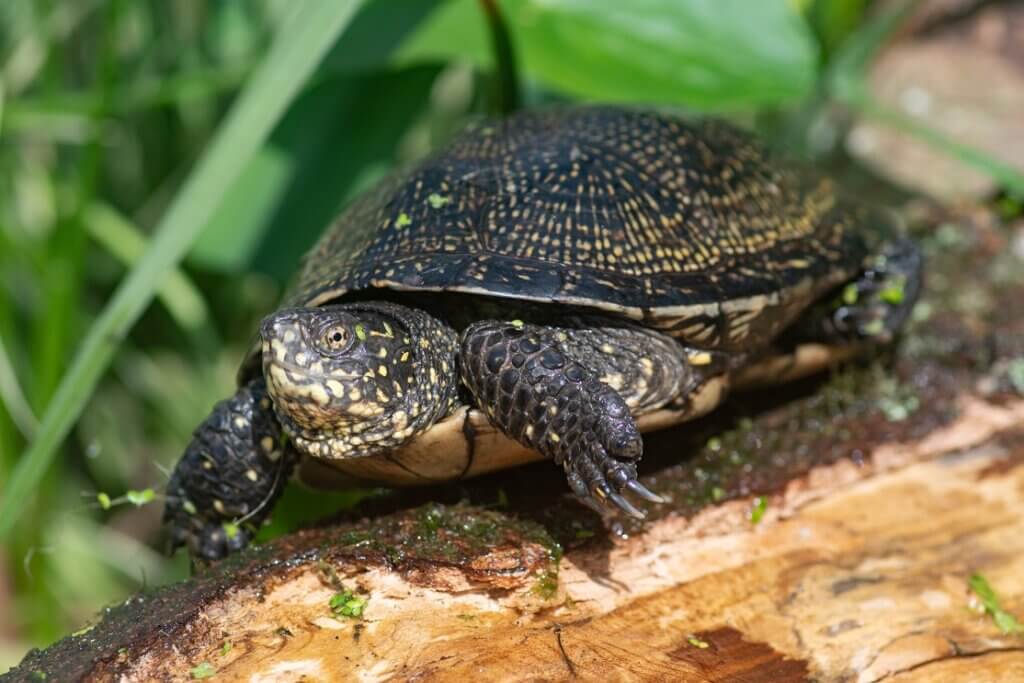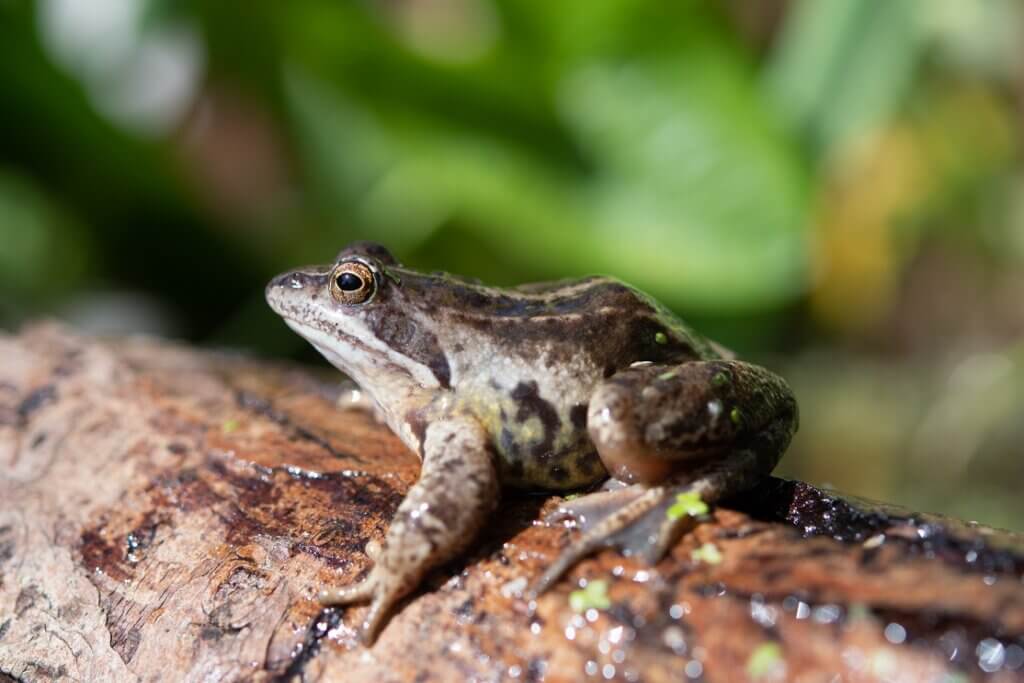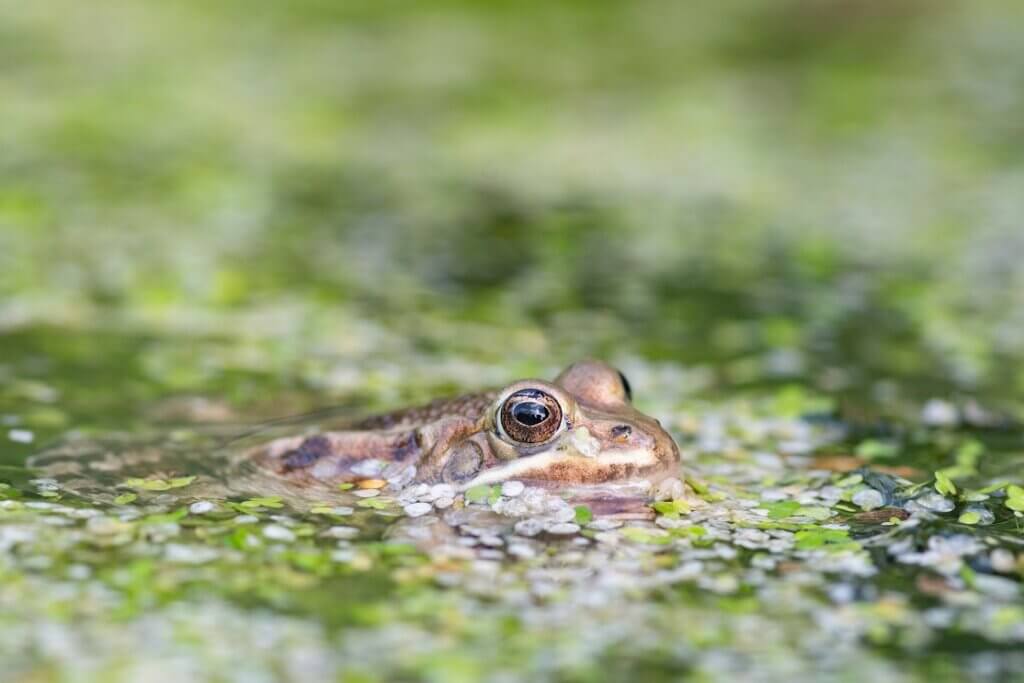
Celtic Reptile & Amphibian is an organisation which focusses on ex-situ conservation of UK and European native herps, through captive breeding. Twitter @CelticReptile See more here.
Harvey Tweats is one Co-director of Celtic Reptile & Amphibian and focusses on ecology and species restoration. He is a longstanding rewilder and widescale nature restoration advocate, inspired by projects such as Knepp and beaver reintroduction.
Tom Whitehurst is the other Co-director of Celtic Reptile & Amphibian, with a focus on networking through social media and species conservation using captive breeding and engagement.
Harvey and Tom were featured in the Guardian earlier this week:

Here they write about their aims and ambitions:
The year is 1836. In the East Anglian wetland, peat excavations have revealed something extraordinarily exotic. Discovered by a ‘Mr Birch’ and lying under two metres of peat is the carapace of a turtle. This turtle was later described as ‘Emys lutaria’ by the ornithologist Alfred Newton. We now call it Emys orbicularis, the European Pond Turtle, and its discovery is a portal into a wilder Britain in which we can all pass.

Britain has a long history of widespread ecological destruction. There is no surprise that our island is home to proportionally less herpetofauna than countries with a similar climate, such as Denmark and Sweden. Over the last 5,000 years we have potentially lost 30 percent of our reptiles and amphibians. This is striking. Yet times are changing, attitudes are changing, the very landscape itself changing. The reality of a Britain enriched with the calls of frogs, basking turtles, and slithering snakes could be close.

Earlier this year, on a cool march day, a chicken-like call was amplified by the polycarbonate of a greenhouse. Inside, a male Moor Frog had locked on to a female, known as amplexus. They entered the water. His body was embalmed in an alien blue hue, testosterone flowing through his tiny veins. Moor Frogs have an incredible ability to turn one of the most unnatural colours known to nature. This weird behaviour is still largely unknown to science, but I am sure of one thing – it is incredible!
Moor Frogs were native to Britain. They were here in Saxon times, as sub-fossil evidence from the fens has shown, and probably during the 15th century. In mainland Europe they amass as giant gatherings around lakes and ponds. Males are very frisky, even attempting to mate with fish. Females look rather hassled and can sometimes drown as multiple males clasp for attention.
Similarly, the Agile Frog – which can jump over two metres – was present in recent times too, and still survives on Jersey as a relict population. It too was found as sub-fossils at multiple sites in England. Unlike the boisterous Moor Frog, the Agile Frog is dainty and delicate. It’s quite nimble, built almost like a gymnast. It is more ordered in its breeding efforts, which start later in March and through to April.
Mentioned in the work of reputable naturalists is the European Tree Frog. Sir Thomas Browne wrote of “the little frog of an excellent Parrat green, that usually sits on Trees and Bushes, and is therefore called Ranunculus viridis, or arboreus”. At our facility it calls from late April until late August, and its quacking ambition reverberates around the streets surrounding us. The neighbours even commented how the chorus reminded them of warm nights holidaying in Florida. This is a species of the classic floodplain and scrub habitat found at rewilding sites such as Knepp, despite the arboreal nature inferred from its name. Unlike tropical tree frogs, these are hardy blighters: just last week one was frozen solid, yet after thawing, was none the worse for its frigid experience!
In our opinion, one of the most fascinating events that takes place in British wildlife is the pursuit of the Grass Snake after amphibian prey. The Grass Snake’s graceful swimming coupled with the dramatic dynamism of two dragons in battle makes this a must-see for any naturalist. Often the Grass Snake swallows the unfortunate newt, frog, or toad in plain sight.
Amphibians account for a large fraction of the biomass in many food webs. Many species rely upon a thriving amphibian population as their main source of food. The Otter is a prime example: amphibians become essential food for Otters at crucial times of year, in the late winter and early spring (when the amphibians start to spawn). Newly reintroduced birds such as White Storks will also benefit from the bio-abundant food supply. Different species of amphibian breed at different times of the year and are active at different times of the day, making them a constant buffet for many creatures.
Amphibians require dynamic, open habitat, exactly the type beavers provide. The initial enclosed beaver project in Devon saw an increase in common frog spawn clumps from 10 to over 580 within 5 years. This is irrefutable evidence that the activity of the ecosystem engineer provides the niches and connections that a diverse amphibian guild requires. Likewise, the insect biomass increased by 80%, thus providing the food needed by a growing amphibian population.
It is no coincidence that as Beaver fur hats were fashioned for pompous aristocrats, the landscape began to lose the croaks of its frogs.
So how do we get them back?

The captive breeding of reptiles and amphibians is well understood and stands as an excellent way to engage the public and learn on a scientific level about these animals. Embracing a hands-on philosophy of raising herps – pioneered by conservationists such as Carl Jones – has (and will have) a direct and much needed impact on their conservation status. We have to remember that this is nothing new. Incredibly successful and engaging projects like the reintroduction of the Pool Frog, Sand Lizard, and Agile Frog on Jersey have already taken place to astounding effect with minimal futility. What our vision entails is this same ethos and sheer will but on a larger scale, utilising new Beaver wetlands and vast rewilding projects.

So, we breed at scale. Scale is everything.
A dedicated breeding facility, centre, or whatever you would like to call it, will allow for the facilitation of more successful reintroductions at Beaver wetlands and rewilding projects such as the Knepp Estate, as well as more typical release sites. Small initial population sizes have hindered the establishment of newly introduced species in the past: captive breeding en masse will eliminate this problem. Dedication is a key word here. In focussing on herps, we can narrow our aim so that our efforts can concentrate on maximum efficiency. This means that disease testing, quarantine, and genealogy can be easily managed. Although good zoos often do incredible work, sometimes they can lose focus on the more common, native species we have in Britain, which is perhaps to be expected when they are dealing with other animals on the verge of extinction! We are a remedy to this.
There is so much to learn through a ‘hands on’ approach via captive breeding, and private breeders and zoological institutions alike will have to play increasingly vital roles in the conservation of species as we rumble on into the Anthropocene.
It was mid-August when we got a knock on the door and a parcel was handed to us from a specialist animal courier. Inside was a stunning, male Western Green Lizard. Although not native to the UK (except on Jersey), they are facing declines in Europe due to the intensification of agriculture. This wasn’t just any Western Green Lizard: it was special. It was the product of over 50 years of dedicated captive breeding by a true reptile enthusiast. Through 50 years of keeping this species, Chris had managed to ensure careful breeding between its relatives and new blood – not outbreeding so that the group lost its locality-specific genotype, but at the same time preventing in-breeding. Chris could even recall the locality of the animal from where its great, great grandparents were collected, all those years ago. This dedication cannot be found anywhere other than private enthusiasts.
Collaboration between ecologists, zookeepers and breeders is something that needs to happen as soon as possible, so that nature can be conserved effectively.
At our breeding facility a major priority is welfare – we constantly ask ourselves, ‘how can we maximise the size of our enclosures while still being able to have an effective role in conservation breeding? The simple answer: keep them outdoors. Outdoor keeping means that our animals are accustomed to the climate of Britain, so they will be at an advantage when the time comes for release. In short, outdoor keeping combines an ethical advantage over traditional indoor keeping) and a conservation value.
Another interesting point worth mentioning is the effectiveness of established ecological translocations of reptiles. A study by Ann Ridell found that Slow Worms often died after being moved to a new site, as the competition from others and unfamiliarity of the habitat get the better of them. Careful reintroduction of young (what we intend to do) can circumvent this.
Disease is a real threat. But we should not overplay it, hindering conservation efforts.
Our company has always treated disease management with the utmost respect. We see a disease such as Chytrid as not only an amphibian killer, but a hope killer – the hope of ever having populations of lost native frogs in the UK again. In most cases, there are only a handful of keepers in the UK with viable captive-bred Pool Frogs, Moor Frogs and Natterjack Toads, for example. As one of those privileged custodians, we must have strict biosecurity measures in place.
Before we even had a thought about a larger scale project, we contacted leading biologists, conservationists, and zoologists about how to impose effective biosecurity measures at our gardens. The advice we got was very useful and absolute, allowing us to piece together a protocol that we, and those we consulted, are happy with. Of course, trying to perform zoo-level biosecurity practices in your back garden is not always going to work! Therefore, upscaling our breeding capacity will make it easier to carry out the necessary protocols. Protocols informed, for instance, by work done by Melbourne Zoo. We have space on our side this time, oh, and enough money to buy a pair of surgical gloves – each!
Jokes aside, our protocol consists of four key steps: quarantine, disinfection, treatment, and assessment.
Firstly, upon arrival to the facility, an animal is placed under a minimum of one month in isolation – far away from the rest of our stock. We keep records of any concerning behaviours. If any amphibians enter the facility, a chytrid test is taken to eliminate the potential of the deadly disease entering our breeding stocks.
Next, if any symptoms of illness are displayed, we would aim to treat the animal following clinical diagnosis. The animal is only released from the quarantine unit after one month of showing no symptoms.
Throughout this entire process, regular disinfections will be performed. We use F10 veterinary disinfectant and Virkon where applicable.
The block system is a method we have made whereby one cannot go between groups of enclosures, ‘blocks’, without disinfecting (foot dip and hand sanitising).
Finally, an important stage in any protocol is to constantly re-evaluate and assess the effectiveness of the current process. We do this by monitoring and conversing with similar projects to see if there is an opportunity to make improvements.
This September gone had an almost May-like, early-summer haze with warmth in the sky, and we took full advantage. With the help of photographer Jack Perks, we began filming a mini documentary – ‘Britain’s Lost Turtle’. In the short film, you travel back to the Neolithic, when the southern wetlands of Britain were home to the European Pond Turtle. It follows a female, who mates and lays her eggs whilst highlighting the challenges she encounters.
When released in October, it was met with great enthusiasm, which almost seemed to breathe life back into the dusty old fossils (originally described by Newton) that now lay not under peat but protective foam and a fossil cabinet, somewhere in storage at Cambridge University. Although the Pond Turtle began to die out in Britain due to cooling in the mid Holocene, human intervention is likely to have hastened their decline, considering how many other large animal extinctions are attributable to our kind. Furthermore, at sites in Scandinavia, direct butchery marks have been found on Pond Turtle shells: a pond turtle makes an easy meal for a hungry Neolithic farmer.
If we are going to see the worrisome, run-away warming projected by climatologists, why not make full advantage of it? In America, climate change is already threatening the sex ratios of turtles, as temperature determines what percentage of eggs will hatch as male or female. As another species susceptible to such incubation changes from warming, the European Pond Turtle will undoubtedly encounter the same fate, at least in southern Europe, sometime soon. That is where we propose an assisted migration, northwards, to where it was native, in ecological terms, very, very recently.
And this is nothing new, at least on the global stage.
We would love to see Pond Turtles back as a flagship for holistic restoration in a time of ecological crisis. Just imagine the complete guild of our native frogs croaking in an orchestrated cacophony, the boom of Bitterns and the roar of Red stags saturating the air as the fiery sun slowly sets over the reed beds, far in the distance of a rewilding project somewhere in the fens.
Our project and mission is undoubtedly ambitious, and in the opinion of some, unattainable. However, what will the world of conservation look like if people stay in their comfort zone? There is no doubt that we need to make changes.
Further links:
[registration_form]
Thanks for posting this. The Pond Turtle is an interesting one. Presumably this would need a release licence so is this something you are likely to pursue in the near future? Or, dare I ask, might you be considering an under the radar approach? Another issue would be whether captive breeding is likely to be better than direct, wild to wild translocation to avoid genetic changes that favour life in captivity? I’m sure you’ve considered both these points as it’s clear you’ve thought very carefully about this whole venture. Good luck in the future (with all that is legal and licenced!).
When I first saw the Guardian article I was rather sceptical, but having seen how they handled themselves on Twitter, and how they have responded via this guest blog, then any fears should be allayed. Although, please do ‘overplay’ the disease threat – but that doesn’t necessarily mean inaction.
Good luck.
Inspirational and uplifting – thanks guys!
Remembered collecting cards from PG tips in the early 60s
and was sure there was a tree frog card and I’d never seen one in Northamptonshire.
But thanks to Mrs Google here it is
https://www.ebid.net/us/for-sale/vintage-1963-brooke-bond-tea-card-wildlife-in-danger-no-48-pine-barren-tree-frog-189963893.htm
1963 Wildlife in Danger. Haven’t come very far have we. Not helped by hiding the facts behind shifting base lines.
Isn’t ‘shifting baselines’ a psychological phenomenon that we are all potentially prone to rather than a devious tactic of the powers that be? Data on the extent of wildlife declines are readily available for a wide range of taxa.
As to how far we have come since 1963, the sad truth is that for many species and habitats we have come rather a long way – in the wrong direction. Perhaps though, there are some grounds for optimism in that the problems are more widely recognised and acknowledged than they were in the early 1960s and lots of people are trying to do something about it including the two enterprising young men who wrote the OP.
When Mark posted the Guardian article about your work it was one of the biggest morale boosters I’ve encountered in ages. Our amphibian fauna especially is depressingly limited compared to even the near continent and if that’s partly down to human agency and it can be corrected that’s bloody good news – moor frogs turning blue delights me, just how exciting would it be for British schoolkids to see that!?! Pretty exciting for an old fart like me too. Likewise having pond turtles back would be fantastic – there’s absolutely no way they’d pose a threat to other wildlife and having them here (if the climate is benign enough for them to breed) would mean the UK has another species it can assist in the conservation of.
I suspect I’ll be teaching my granny to suck eggs, but I’ll bet my last dollar you’ll get a lot of hysterical rubbish about ‘introduction’. There’s an inverse relationship between very public, loud and somewhat sanctimonious declarations from some about the dangers of introduction, and then any focus especially involving physically dealing with genuinely problematic on the ground. I’ve read of Scottish sea eagles being maligned because they are derived from translocated Norwegian birds therefore they’re supposedly non native – which is just idiocy. Meanwhile many of our woodlands are losing their native fauna and flora to the spread of various invasive shrubs such as rhododendron, cherry laurel and snowberry that were planted out as cover for gamebirds and this is still going on quite legally – https://www.ashridgetrees.co.uk/nature-mix – and there’s hardly a bloody peep about that, but I bet you’ve taken a bit of crap already about what is actually bringing back lost fauna. Highlighting anomalies like this might help shut up ill informed and malicious critics.
It would be difficult for me to exaggerate how pleased I am at what you’re doing, I have a special soft spot for European amphibians it’s been 31 years since I last had pets and they were two male green toads which I called Celtic and Hibs due to their green and white(ish) coloration. One of the more common, but distinct experiences I’d have with wildlife when I lived in Hungary was watching an expanding circle of marsh frogs leap from the margins towards the centre of a pond when anyone approached. If pool frogs are anything like them then they’ll be an incredible boost as a food source to the wide range of species I imagine could eat them. Currently there’s nothing comparable in the UK. Believe it or not I once came across a closed UK government petition (I just tried goggling for it without success) that wanted agile and/or moor frogs to be reintroduced here. It had only got about seven signatures. Who knows with more championing this might be an option for the future. All the best you both deserve it.
Very good account of what you are trying to do. I think this Will have allayed to some extent many of the fears of conservationists. I find it uplifting that there are people whose commitment gives others hope and inspiration and puts a banger under the bottoms of those in Power who count on ignorance and indifference to advance their plans to stifle the calls for change and progress in conservation.
Fascinating, I would love to be able to build a wildlife pond to help support and sustain
Richard – thank you for your first comment here.
Good luck lads, I said very similar things back in 1981 at the RSPB members weekend at York, only to be told there will never be a reason for anyone to keep any bird in captivity ever, and we will never do it.
Ha ha now a key part of their conservation measure after killing of the hobby of bird keeping with all that knowledge wasted, that rare birds are suffering from not having today to help move forward those captive breeding programs.
I wish you success, plus Jack is also a keen naturalist. With much enthusiasm for his photo subjects, meet him a few times. I wish you all well with the film.
Good luck guys. Hope in ten years time you can clearly demonstrate your approach has paid off and our natural environment is the richer for it.
It is very reassuring to read about the emphasis on biosecurity, and the practical measures being taken, that lays to rest many of my fears. Although I would still like to know more about the sourcing procedure for the amphibs and repts.
“Often the Grass Snake swallows the unfortunate newt, frog, or toad in plain sight.”
I’ve a breeding population of great crested and smooth newts in my pond. Sometimes the frogs and toads are successful as newts can be a bit predatory themselves (on the spawn and tadpoles). Fish are not welcome. Well, perhaps the odd stickleback is not totally unwelcome as there are also breeding dragonflies and thus their larvae.
However late one august there was this grass snake basking by the drive. It was only after that I learned that a favourite snack of a grass snake was a newt. Well, I suppose they have to eat something and the pond does have a turn-over of new newts/efts every year.
I live in the hope that the grass snake is still around, but keeping hidden for the time being.
(Virkon is a disinfectant for viruses and bacteria. Useful for boot baths before visiting the enclosed chickens on account of biosecurity for avian flu. A fetching purplish-pink granular substance with dire warnings of eye damage whish is dissolved in water at various concentrations, depending on use. According to the marketing it must be better than bleach as it states 99.999% dead within 10 minutes.)
Good luck with your venture.